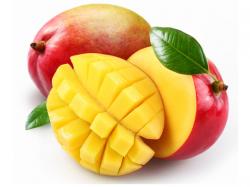National Mango Board Provides Information On Best Mango Handling Practices
August 29, 2013 | 3 min to read

Orlando, Fla. – The National Mango Board (NMB) hosted its second free Mango Temperature Management and Ripening Webinar on August 22, 2013 for retailers and importers. This webinar focused on providing attendees with information on how to best handle mangos and the importance of proper temperature management to enhance consumers’ mango eating experience.
In conjunction with the University of California, Davis (Department of Plant Science) and the University of Florida (IFAS Center for Food Distribution and Retailing), the NMB hosted this free webinar to share its initial findings of their Ripe and Ready to Eat mango program (RRTEMP) initiative with the industry. Preliminary findings from their RRTEMP suggest that mangos stored in cold temperatures prevent the tropical fruit to ripen in the appropriate time for consumers to purchase and enjoy. The webinar also gave insight on consumer preferences to help determine the minimum quality standards consumers will accept.
During the webinar, ripening expert Dennis Kihlstadius, Produce Technical Services, shared his preliminary findings and recommendations for stores and distribution centers. As reported in the webinar, Kihlstadius’ recommendations included improving temperature management at all distribution levels during transportation and storage, as well as mango displays at store level. Kihlstadius emphasized that mangos should not be refrigerated and should not be transported or stored below 54 degrees Fahrenheit.
Dr. Jeffrey Brecht, UF/IFAS Center for Food Distribution & Retailing – University of Florida, shared his preliminary findings and recommendations for importers’ and retailers’ warehouses and stores. Dr. Brecht recommended choosing appropriate temperatures when trying to slow ripening and avoid chilling (55 degrees Fahrenheit), and to help promote ripening (68-72 degrees Fahrenheit). Another key suggestion for stores is to display mangos at room temperature to allow mangos’ aroma to develop.
In addition, Dr. Carlos Crisosto, Department of Plant Sciences – University of California, Davis, is helping the NMB to create a complete descriptive analysis of Tommy Atkins, Kent, Ataulfo, Keitt, Haden and Francis mango cultivars from the top six producing countries. A minimum quality index will be developed to help determine the minimum quality standards consumers will accept; engaging them to purchase mangos and increase consumer satisfaction. Dr. Crisosto shared during the webinar that ripe mangos have higher consumer acceptance than mature mangos. He also indicated that ripe soluble solids concentration (RSSC) and dry matter (DM) are great predictors for consumer acceptance. DM can predict consumer acceptance in both mature and ripe mangos.
Furthermore, Wendy McManus, NMB Retail Program Manager, highlighted the wealth of tools available at www.mango.org/retail. Retailers can find an extensive amount of resources under their handling and merchandising tab which includes the Mango Maturity and Ripeness Guide (color chart) for receiving, the Mango Backroom Poster for store-level training and the Mango Postharvest Best Management Practices Manual. Also available on their website, is a newly designed back room piece titled “Treat me like a banana!” to help inform retail produce departments that like bananas, mango should not be refrigerated in the back room or on display. It also states that mangos can suffer chill damage and loss of flavor if held below 54 degrees Fahrenheit. The new back room piece can be ordered using the POS order form at www.mango.org/industry/point-sale-materials.
The NMB’s Mango Temperature Management and Ripening Program Webinar for retailers and importers is now available on their website for viewing at www.mango.org/retail/best-practices. Speaker presentations are also available for download.
About National Mango Board
The National Mango Board is a national promotion and research organization, which is supported by assessments from both domestic and imported mangos. The board was designed to drive awareness and consumption of fresh mangos in the U.S. One cup of mango is only 100 calories, an excellent source of vitamins A and C, a good source of fiber and an amazing source of tropical flavor.
Mango availability per capita has increased 32 percent since 2005 to an estimated 2.47 pounds per year in 2012. Mango import volume for 2012 was 804 million pounds. Learn more at www.mango.org.
Source: National Mango Board
